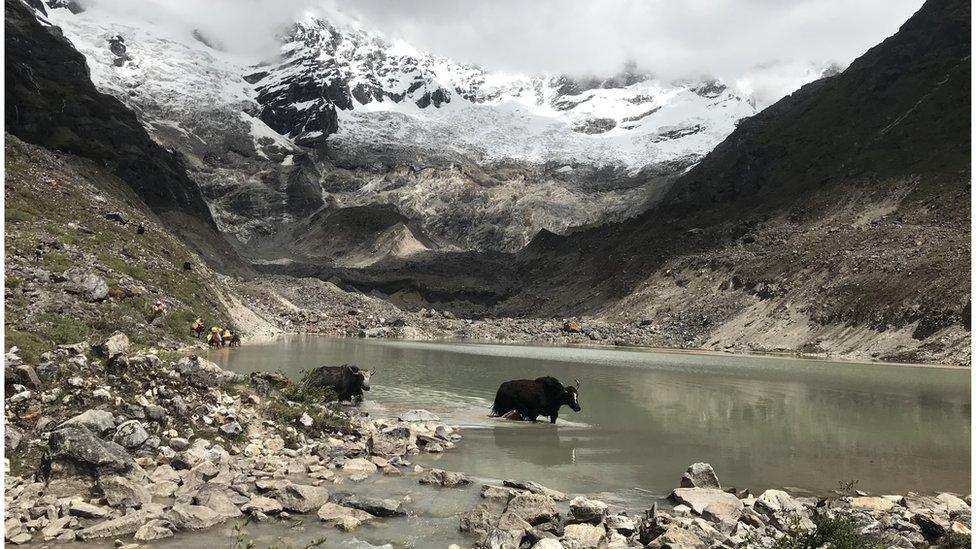Millions face threat of flooding from glacial lakes
- Published

A glacial lake at the foot of Jomolhari mountain in Bhutan.
Up to 15 million people face risk of catastrophic flooding from glacial lakes which could burst their natural dams at any moment, a new study finds.
The study led by Newcastle University is the first global attempt to map potential hotspots for such floods.
As the climate warms, glaciers retreat and meltwater collects, forming lakes.
The impact of global warming on glacial lake floods is yet to be defined, but it has increased both the volume and number of glacial lakes worldwide, external.
The study published in the journal Nature Communications, external assessed the conditions of lakes and the number of people living downstream from them, which has also increased significantly.
'There are a large number of people globally exposed to the impacts of these floods," said Rachel Carr, a glaciologist at Newcastle University and an author on the paper.
"It could happen at any point - that's what makes them particularly dangerous, because it's hard to predict exactly when they will happen."
The authors say those facing the greatest threat live in mountainous countries in Asia and South America.
People living in India, Pakistan, Peru and China account for over half of those at risk. In Asia, around one million people live within just 10km of a glacial lake.
"It's how close people are to those lakes, and their capacity to respond to the disaster that's important," said Dr Carr.
"People have done a lot of inventory studies [of the lakes] ... but our study has flipped that around.
"What's downstream matters just as much, if not more. I think it's an important reframing in the way we think about it."
Lakes formed by melting glaciers have natural dams of loose rocks and ice that can fail suddenly and unpredictably.
The floods that follow come thick and fast, in many cases being powerful enough to destroy vital infrastructure.

A bridge partially collapsed due to flooding from a glacial lake outburst in Pakistan last year
Dam failures are complex, but are often triggered when a lump of rock or ice falls into the lake from the surrounding mountains.
That causes a wave to travel across the lake like a tsunami, destabilising the dam as it reaches it.
Other factors include a gradual build-up of meltwater, increasing pressure against the dam and melting any ice cores holding it together.
Rather than try to predict which dams were most likely to fail, the study's authors looked at which lakes would pose the most danger if they burst out.
They also stress the importance of early warning systems such as time-lapse cameras.
"It's an important paper," said Stephan Harrison, a leading expert on the impact of climate change on glacial lakes at the University of Exeter, who was not involved in the research. "It alerts policymakers to the likely impact of future climate change."
Dr Harrison added that the research was only a first step towards better understanding of the impact of climate change on what are known as glacial lake outburst floods (GLOFs).
That relationship is complex and made harder to prove by what scientists suspect to be a long time lag between cause and effect.
Research shows that an increase in floods which began in the early 20th Century and peaked in the 1970s could be a lagged response to climatic changes in the past., external
While scientists expect that glacial floods will increase as a result of human-induced climate change, there has as yet been no such increase.